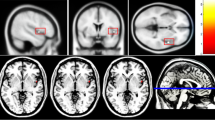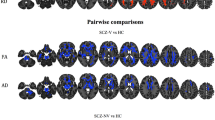Abstract
To investigate the association between the volume of amygdala subnuclei and violent behaviors in patients with schizophrenia (SCZ). In the present study, we recruited 40 SCZ patients with violent behaviors (VS), 26 SCZ patients without violent behaviors (NVS), and 28 matched healthy controls (HC) who completed T1-weighted magnetic resonance imaging. Both the total amygdala and amygdala subnuclei volumes were estimated with FreeSurfer. When comparing the SCZ patients with HC, SCZ patients had a smaller volume of the left basal nucleus (P < 0.05, uncorrected). Further, the VS patients had a smaller volume of the left amygdala central nucleus than the NVS group (P < 0.05, Bonferroni corrected). Our study suggests that a smaller volume of the left amygdala basal nucleus may be a biomarker for SCZ and that a smaller volume of the left central nucleus may be relevant to violence risk in patients with schizophrenia.

Similar content being viewed by others
Data availability
The data and materials can be provided upon reasonable requests.
References
Alderman, N., Knight, C., & Morgan, C. (1997). Use of a modified version of the Overt Aggression Scale in the measurement and assessment of aggressive behaviours following brain injury. Brain Injury, 11(7), 503–523.
Amano, T., et al. (2011). The fear circuit revisited: Contributions of the basal amygdala nuclei to conditioned fear. Journal of Neuroscience, 31(43), 15481–15489.
Anglada-Figueroa, D., & Quirk, G. J. (2005). Lesions of the basal amygdala block expression of conditioned fear but not extinction. The Journal of Neuroscience, 25(42), 9680.
Bacq, A., Astori, S., Gebara, E., Tang, W., Silva, B. A., Sanchez-Mut, J., Grosse, J., Guillot de Suduiraut, I., Zanoletti, O., Maclachlan, C., Knott, G. W., Gräff, J., & Sandi, C. (2020). Amygdala GluN2B-NMDAR dysfunction is critical in abnormal aggression of neurodevelopmental origin induced by St8sia2 deficiency. Molecular Psychiatry, 25(9), 2144–2161. https://doi.org/10.1038/s41380-018-0132-3
Barkataki, I., et al. (2006). Volumetric structural brain abnormalities in men with schizophrenia or antisocial personality disorder. Behavioural Brain Research, 169(2), 239–247.
Barth, C., et al. (2021). In vivo amygdala nuclei volumes in schizophrenia and bipolar disorders. Schizophrenia Bulletin, 47(5), 1431–1441.
Buckley, P. F., et al. (2004). Insight and its relationship to violent behavior in patients with schizophrenia. American Journal of Psychiatry, 161(9), 1712–1714.
Coid, J. W., et al. (2013). The relationship between delusions and violence: Findings from the East London first episode psychosis study. JAMA Psychiatry, 70(5), 465–471.
Dale, A. M., Fischl, B., & Sereno, M. I. (1999). Cortical surface-based analysis I. Segmentation and surface reconstruction. Neuroimage, 9(2), 179–194.
Del Bene, V. A., et al. (2016). Neuroanatomical Abnormalities in Violent Individuals with and without a Diagnosis of Schizophrenia. PLoS ONE, 11(12), e0168100.
Dolan, M. C., & Fullam, R. S. (2009). Psychopathy and functional magnetic resonance imaging blood oxygenation level-dependent responses to emotional faces in violent patients with schizophrenia. Biological Psychiatry, 66(6), 570–577.
Elbogen, E. B., & Johnson, S. C. (2009). The intricate link between violence and mental disorder: Results from the National Epidemiologic Survey on Alcohol and Related Conditions. Archives of General Psychiatry, 66(2), 152–161.
Fazel, S., et al. (2009). Schizophrenia and violence: Systematic review and meta-analysis. PLoS Medicine, 6(8), e1000120.
Feinstein, J. S., et al. (2011). The human amygdala and the induction and experience of fear. Current Biology, 21(1), 34–38.
Fischl, B., et al. (2002). Whole brain segmentation: Automated labeling of neuroanatomical structures in the human brain. Neuron, 33(3), 341–355.
Fischl, B., et al. (2004). Automatically parcellating the human cerebral cortex. Cerebral Cortex, 14(1), 11–22.
Gill, K. M., Miller, S. A., & Grace, A. A. (2018). Impaired contextual fear-conditioning in MAM rodent model of schizophrenia. Schizophrenia Research, 195, 343–352.
Haller, J. (2018). The role of central and medial amygdala in normal and abnormal aggression: A review of classical approaches. Neuroscience and Biobehavioral Reviews, 85, 34–43.
Hoptman, M. J., et al. (2010). Amygdalofrontal functional disconnectivity and aggression in schizophrenia. Schizophrenia Bulletin, 36(5), 1020–1028.
Hrybouski, S., et al. (2016). Amygdala subnuclei response and connectivity during emotional processing. NeuroImage, 133, 98–110.
Huang, H. C., et al. (2009). The reliability and validity of the Chinese version of the modified overt aggression scale. International Journal of Psychiatry in Clinical Practice, 13(4), 303–306.
Koo, J. W., Han, J.-S., & Kim, J. J. (2004). Selective neurotoxic lesions of basolateral and central nuclei of the amygdala produce differential effects on fear conditioning. The Journal of Neuroscience, 24(35), 7654.
Laszlo, K., et al. (2016). Positive reinforcing effect of oxytocin microinjection in the rat central nucleus of amygdala. Behavioural Brain Research, 296, 279–285.
Leucht, S., et al. (2016). Dose equivalents for antipsychotic drugs: The DDD method. Schizophrenia Bulletin, 42(Suppl 1), S90–S94.
Naudts, K., & Hodgins, S. (2005). Neurobiological Correlates of Violent Behavior Among Persons With Schizophrenia. Schizophrenia Bulletin, 32(3), 562–572.
Onishi, B. K. A., & Xavier, G. F. (2010). Contextual, but not auditory, fear conditioning is disrupted by neurotoxic selective lesion of the basal nucleus of amygdala in rats. Neurobiology of Learning and Memory, 93(2), 165–174.
Patki, G., et al. (2015). High aggression in rats is associated with elevated stress, anxiety-like behavior, and altered catecholamine content in the brain. Neuroscience Letters, 584, 308–313.
Peralta, V., & Cuesta, M. J. (1994). Psychometric properties of the positive and negative syndrome scale (PANSS) in schizophrenia. Psychiatry Research, 53(1), 31–40.
Saygin, Z. M., et al. (2017). High-resolution magnetic resonance imaging reveals nuclei of the human amygdala: Manual segmentation to automatic atlas. NeuroImage, 155, 370–382.
Shackman, A. J., & Fox, A. S. (2016). Contributions of the central extended amygdala to fear and anxiety. Journal of Neuroscience, 36(31), 8050–8063.
Struber, D., Luck, M., & Roth, G. (2008). Sex, aggression and impulse control: An integrative account. Neurocase, 14(1), 93–121.
Tani, H., et al. (2019). Comparison of emotional processing assessed with fear conditioning by interpersonal conflicts in patients with depression and schizophrenia. Psychiatry and Clinical Neurosciences, 73(3), 116–125.
Tesli, N., van der Meer, D., Rokicki, J., Storvestre, G., Røsæg, C., Jensen, A., Hjell, G., Bell, C., Fischer-Vieler, T., Tesli, M., Andreassen, O. A., Melle, I., Agartz, I., & Haukvik, U. K. (2020). Hippocampal subfield and amygdala nuclei volumes in schizophrenia patients with a history of violence. European Archives of Psychiatry and Clinical Neuroscience, 270(6), 771–782. https://doi.org/10.1007/s00406-020-01098-y
Uliana, D. L., Resstel, L. B. M., & Grace, A. A. (2018). Fear extinction disruption in a developmental rodent model of schizophrenia correlates with an impairment in basolateral amygdala-medial prefrontal cortex plasticity. Neuropsychopharmacology, 43(12), 2459–2467.
Wallace, C., Mullen, P. E., & Burgess, P. (2004). Criminal offending in schizophrenia over a 25-year period marked by deinstitutionalization and increasing prevalence of comorbid substance use disorders. American Journal of Psychiatry, 161(4), 716–727.
Yang, Y., et al. (2010). Reduced hippocampal and parahippocampal volumes in murderers with schizophrenia. Psychiatry Research, 182(1), 9–13.
Yoder, K. J., Porges, E. C., & Decety, J. (2015). Amygdala subnuclei connectivity in response to violence reveals unique influences of individual differences in psychopathic traits in a nonforensic sample. Human Brain Mapping, 36(4), 1417–1428.
Zagrodzka, J., et al. (1998). Contrasting expressions of aggressive behavior released by lesions of the central nucleus of the amygdala during wakefulness and rapid eye movement sleep without atonia in cats. Behavioral Neuroscience, 112(3), 589–602.
Zhang, M., et al. (2020). Abnormal amygdala subregional-sensorimotor connectivity correlates with positive symptom in schizophrenia. Neuroimage Clinical, 26, 102218.
Acknowledgements
We thank Dr Yingying Tang who helped with the language revisions and Professor Yang Zhi who helped to modify our statistic.
Funding
This study is supported by grants from the Three-Year Action Plan for the Construction of Public Health System in Shanghai [grant number: GWIV-5, PI: Bin Xie]; the Science and Technology Commission of Shanghai Municipality [grant number 19411969400, PI: Xinyi Cao]; the National Natural Science Foundation of China[grant number 82271924, PI: Bin Xie; grant number 81873909, PI: Qiang Luo]; Quantitative evaluation based strategic research of interventions on relapse of schizophrenia [grant number 19411950800, PI: Bin Xie], Fund for Talents by Shanghai Mental Health Center [grant number 2018-FX-04, PI: Qian Guo], Qihang Foundation of Shanghai Mental Health Center [grant number 2019-QH-01, PI: Hao Hu]. The sponsor had no role in study design, in the collection, analysis, and interpretation of data, in the writing of the report, or in the decision to submit the paper for publication.
Author information
Authors and Affiliations
Contributions
Yang Shao, and Bin Xie designed the study protocol and supervised the administration of the study. Yi Qiao colleceted the MRI data. Hao Hu did the analysis and wrote the primary manuscript. Fengju Liu, Li Liu and Yi Mei collected the clinical data.
Corresponding authors
Ethics declarations
Ethical approval
All study procedures were approved by the Institutional Review Board of Shanghai Mental Health Center, which was in accordance with the Declaration of Helsinki.
Consent to participate
Written informed consents were provided by all the participants.
Consent to publish
All authors consented this paper to be published in Brain imaging and behaviors.
Competing interests
None.
Additional information
Publisher's note
Springer Nature remains neutral with regard to jurisdictional claims in published maps and institutional affiliations.
Rights and permissions
Springer Nature or its licensor (e.g. a society or other partner) holds exclusive rights to this article under a publishing agreement with the author(s) or other rightsholder(s); author self-archiving of the accepted manuscript version of this article is solely governed by the terms of such publishing agreement and applicable law.
About this article
Cite this article
Hu, H., Liu, F., Liu, L. et al. Smaller amygdala subnuclei volume in schizophrenia patients with violent behaviors. Brain Imaging and Behavior 17, 11–17 (2023). https://doi.org/10.1007/s11682-022-00736-4
Accepted:
Published:
Issue Date:
DOI: https://doi.org/10.1007/s11682-022-00736-4




